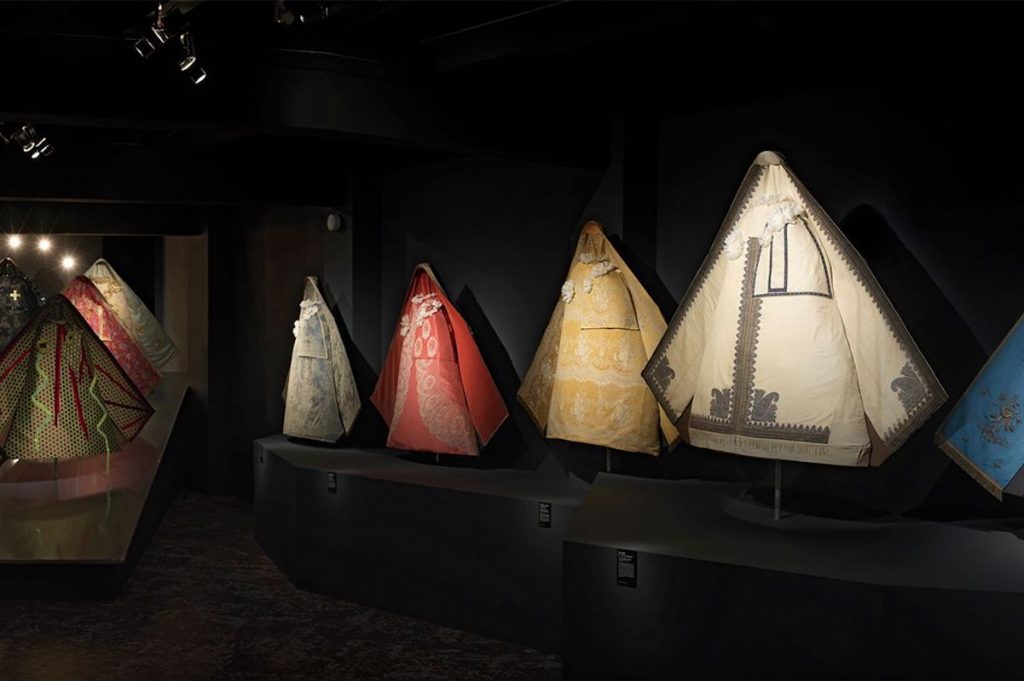Fashion Icon
On the occasion of the exhibition “Icon of Fashion”, the Museum of Fabrics reveals a very unexpected history of fashion. For the muse of this creation is none other than the Virgin Mary. For nearly six hundred and fifty years, the statues of the Virgin have possessed a veritable wardrobe, composed of majestic costumes, glittering with jewels and pearls, offered by the sovereigns or the simple faithful. Recently, big names in Haute Couture have designed new clothes for a statue of the Black Virgin of Toulouse. Thus antique gold embroidered fabrics and contemporary camouflage pattern meet in a selective design of the costume and body since only the visible face of the statue is adorned. In the heart of the Basilica of Notre-Dame-la-Daurade in Toulouse, a black Virgin, reputedly miraculous, dominates the altar where her worship is celebrated. The original statue, burned during the Revolution, was replaced at the beginning of the 19th century by a dark Madonna, sculpted identically, whose head, right arm and child appear amid sumptuous fabrics. For this black Virgin is dressed and has a real wardrobe, changed according to the holidays and the liturgy. The statue is thus covered in a robe, a veil, and an additional dress, in miniature, dresses the Child Jesus. No less than twenty-two dresses, each accompanied by his veil and the dress of Christ, are presented in the exhibition. In 2009, Haute Couture designers renewed this extraordinary wardrobe and made new outfits for the statue. Jean-Charles de Castelbajac’s Battle Dress, with the motif of camouflage, evokes a strong and protective Virgin, treading at the foot of the serpent of evil, protecting peoples bruised by conflict. Franck Sorbier’s Festive Dress recalls the outfits of 18th century sovereigns: it is made of silk canvas and gold threads, embroidered with metallic lace, beads, tubes and glass rockeries. Jean-Michel Broc’s Dress of Lent, made of viscose paper, uses this artificial fiber from the wood, produced by the earth, evokes the motherhood of the Virgin. It is plum-coloured, to symbolize mourning and Lent, but velvet ribbons, soft as the young, young, green shoots, herald the renewal. This Madonna dressed in Haute Couture is no exception.
Since the 19th century, the miraculous statues of the Virgin have each had their own wardrobes, in France, Spain, Italy or Germany. The Romanesque majesties, with their brown complexions, the Gothic Virgins, full of tenderness, the articulated and painted statues of the 18th and 18th centuries were dressed in sumptuous silks, fabrics embroidered with gold and silver, embellished with pearls and cabochons, lace, offered by the sovereigns or by anonymous faithful. Far from concealing the sculptures, these dummy garments gave the statues a spectacular, almost theatrical, and so human presence. The exhibition presents, in addition to the wardrobe of the Black Virgin of the Sea bream, other clothes from these wardrobes now unknown. Fragile and coveted for the richness of their constituent materials, decried by critics of an expression of faith deemed too popular, these locker rooms have often been destroyed or disappeared. The presentation of these robes of virgin statues at the Museum of Fabrics is therefore exceptional and allows to evoke more than six hundred and fifty years of a prestigious creation, reserved for the one that was considered by its dressmakers as the Queen par excellence.
